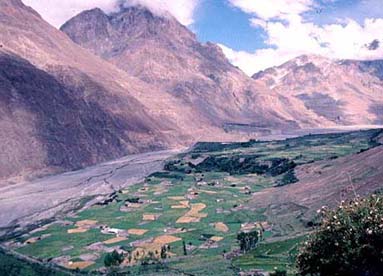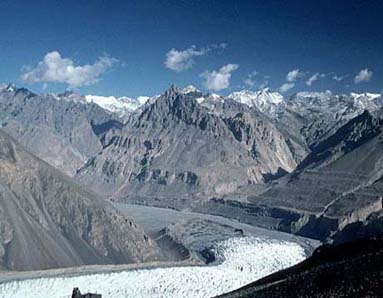John Mock & Kimberley O'Neil



John Mock & Kimberley O'Neil |
||
|
|
||



|
Shimshal Nature Trust (SNT)written by Shimshal VillageVisit the Shimshal Nature Trust website.
Johar Ali, email: shuwert@hotmail.com 1.0 IntroductionShimshal is one of the mountainous villages of Pakistan, situated at the Sino-Pakistan border. Shimshal is one of Pakistan's few mountain communities that retains a strong commitment to a surplus oriented economy based on transhumant livestock herding and agricultural productions. Shimshalis also retain environment beliefs, knowledge and practices that have been lost elsewhere. Being in a complete natural atmosphere, Shimshalis are eager to enjoy the benefits of increasing access to the outside world. Shimshalis feel a strong obligation to preserve their unique physical and cultural environment. Until recently Shimshal has not felt the necessity for a formalized environment stewardship program. More than four hundred years of sustainable interaction with the landscape offered ample proof of the sustainability of community members' environmental practices. In the past decade, however, progressively greater access to, and interaction with, the outside world has threatened to both alter the communities' traditional relationship with its environment and to remove control of that relationship from the community. As local and foreign trekkers, and increasingly, foreign researchers visit the community in great number, they too influence local environment practices and may place stress on limited resources. Villagers realize that all of these impacts are likely to multiply when the road is completed, and feel the time is ripe for a formal enumeration and evaluation of indigenous environmental practices. The effort to develop a Shimshal Nature Trust is also partly a response to the community's unsatisfactory experience with Khunjerab National Park. The park's primary purpose at the time it was created was to protect the habitats of rare species of Asian mountain wildlife, especially the endangered Marco Polo Sheep. The park's 2300 square kilometers have been interpreted by administration to include most of Shimshal's pastoral territory, as well as the communal pastures of six other villages. However, as the rigid national park standards have not yet been enforced, Shimshal continues to graze its pasture as always. Shimshal alone is unwilling to relinquish access to its pasture under any circumstances, a position the community justifies by emphasizing the great size of territory under threat of appropriation, the community's exceptional economic reliance on herding and corresponding lack of access to the economic opportunities provided to other communities by their proximity to the Karakoram Highway, and by outlining the community's historical and current symbolic attachment to parts of the territory under threat. Although Shimshalis have succeeded so far in resisting park management of their main pastures, they greatly resent the continued threat of external control, and fear that such control would jeopardize both their cherished culture and the very environment the park was meant to protect. Recent evidence that endangered wildlife is more plentiful in Shimshal territory than in areas currently under park management validates the community's fear and legitimizes Shimshalis resistance to the park. In keeping with this, Shimshalis decided to constitute their Shimshal Nature Trust around a broad definition of environment, which includes socio-cultural and ecological components in relationship with each other. The Nature Stewardship program is one of these which are discussed in detail as under. 2.0 Shimshal Environmental EducationThe concept of environmental education in Shimshal is slightly different from the western-based concept. Shimshal environmental education is aimed at strengthening the relationship between people and the physical and spiritual environment in the perspective of their culture and traditions. Great emphasis is placed on developing understanding and respect in the people for their surroundings instead of concentrating and exploiting a self-created issue like pollution, depletion of forest, etc., as are practiced in modern environmental education. The students are educated to encode and analyze the traditional environmental practices and beliefs and to correlate the findings with modern techniques. 2.1 Activities and Achievements of First Phase of Visionary Plan (1994-1998)Generalized data collection for the last five years in respect of fauna and flora, livestock, population, daily life, weather, tourism, politics and society management, history, agriculture and metrology has been carried out by the students of the Diamond Jubilee Girls and Government Boys schools in Shimshal, under the supervision of their teachers. The annual reports have been compiled and issued. Work on the 2nd phase of the plan is in progress in which specialized research will be undertaken by college and university students in their respective fields. 3.0 Self Help Village Development Program (SHVDP)Shimshal remained isolated for more than four hundred years as a self sufficient agro-pastoral based community and even today, Shimshal upholds and enjoys the status. As a result, the community possesses a long history of indigenous communal self-help development. Traditionally, many initiatives were sponsored by individual households who chose a project and supplied materials and food to the community volunteers to accomplish the task. In such a way a number of projects such as channels, bridges, trails, travelers shelters and domestic livestock huts were constructed all over the territory of Shimshal Valley. The formation of SHVDP simply formulated all those traditional enthusiastic efforts for community development in an organized manner in line with the modern management techniques. A committee from the community institutions has been constituted. The committee is responsible to identify the projects and post a list of priorities. The list is then presented to the village for sponsorship. Households wishing to sponsor a public work are required to choose from among the top priorities set by the committee and the work is undertaken by the Shimshal Scouts, Girls Guides and community volunteers. 3.1 Activities and Achievements
4.0 Shimshal Culture ProgramThe culture and traditions of Shimshal, as old as 500 years, are comparatively more original than other cultures elsewhere in the Northern Areas, mainly due to Shimshal's remoteness and long isolation. The culture of this isolated valley is a beautiful blend of many cultures such as Pamir culture, the Hunza culture and Chinese Turkistan culture. The Shimshal Cultural Program has been operating for several years. 4.1 Activities and Achievements
5.0 Visitors Program And Mountaineering School (VPAMS)The Shimshal's Visitors Program was established to facilitate tourism and research activities without stressing the cultural and ecological environment. In particular, Shimshalis would like to establish a Visitors Resource Center to encourage and assist the visitors and researchers to both learn about the community and to share their expertise with the community. The ultimate goal of VPAMS is to channelize the skills and expertise of famous Shimshali climbers by establishing a Mountaineering School, as a part of the tourism program. Through this school, interested young trekkers and mountaineers will be trained in rock climbing, ice climbing and skiing. The schools will also organize and arrange Pakistani expeditions to the famous peaks of Pakistan. 5.1 Activities and Achievements
6.0 Shimshal Nature Stewardship Program (SNSP)Shimshalis feel a strong obligation to preserve their unique physical and cultural environment. Shimshal is one of Pakistan's few mountain communities that retains a strong commitment to environmental beliefs, knowledge and practices that have been lost elsewhere. The Shimshal Nature Stewardship Program is an effort to formalize all those environmental beliefs, knowledge and practices of the Shimshal culture and tradition into a language and structure that is accessible to the international ecological community. 6.1 Activities and Achievements
|
Go to >>
Trekking in the Karakoram & Hindukush - a Lonely Planet walking guide,
Pakistan Trekking & Mountaineering Statistics,
Shimshal,
Karakoram, Hindukush & Pamirs Reading List for Travelers & Trekkers,
Pakistan Tour Operators & Trekking Companies
 Copyright Text & Photographs © John Mock & Kimberley O'Neil 1997-2025 All rights reserved. Unauthorized redistribution of this document is prohibited. |